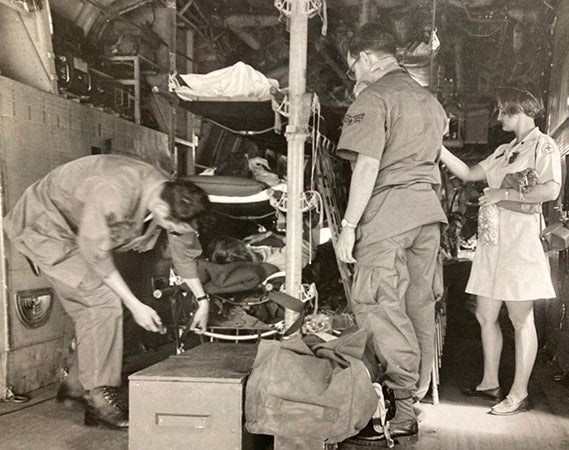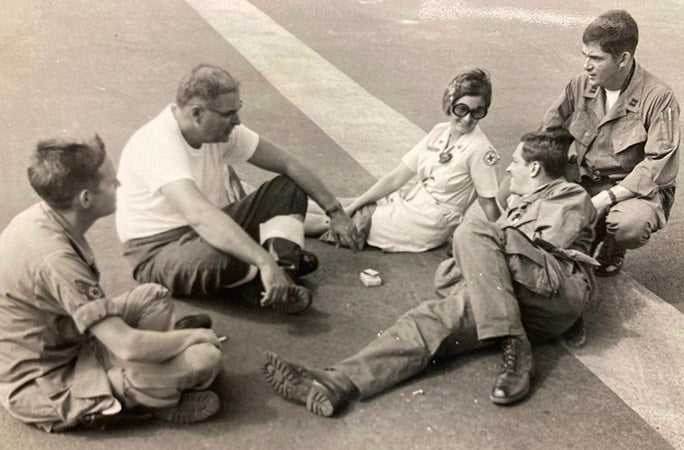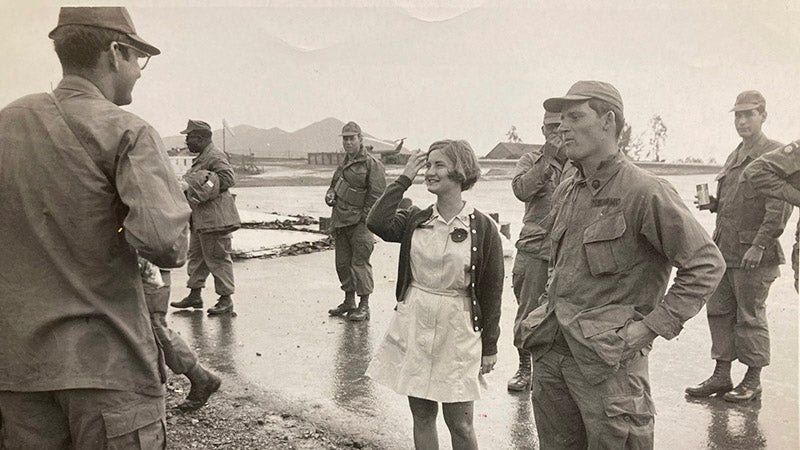Remember When: Donut Dollies in Vietnam
Published 2:00 pm Friday, November 12, 2021
|
Getting your Trinity Audio player ready...
|
The young women who served in South Vietnam with the Red Cross Supplemental Recreation Activities Overseas (SRAO) program were known informally as Red Cross recreation workers. To the American men who served during the Vietnam War, they were known simply as the “Donut Dollies.”
In author Nancy Smoyer’s book, “Donut Dollies in Vietnam,” she writes, “Ask any ‘Donut Dolly’ why she was in Vietnam and she would tell you that she was there because the men were there. Ranging from large bases such as Cam Ranh Bay to forward Landing Zones and Firebases, their job was to provide GIs with a brief respite from the war through games, Kool-Aid, or just their presence.”
As a member of the Covington Veterans Foundation, I have been helping to gather information, artifacts, and stories for the recent “Celebration of Heroes” event that was held here in Andalusia at the AHS auditorium along with a running display at the City Hall. The theme this year was the Vietnam War.
Here is the story of a college friend of mine. We were in the U of A “Million Dollar Band” together in the late 1960s. Freida, who is an Alabama girl and whose hometown is Uriah near Monroeville, was graduated from college a year before I was. I began teaching choral music after my graduation in 1969, and the next thing I know, I got a letter from her in Vietnam. After her college graduation from the University of Alabama in 1968, she had taken a teaching job with the Department of Defense in Columbus, Georgia and had been a Red Cross volunteer during that time. Little did I know that she learned about the opportunity to join the Red Cross SRAO, and she did just that. I received several letters and pictures from her during her term of service in South Vietnam which lasted from June 1969 through May of 1970.
When she returned, I played the piano for her wedding at the Uriah Baptist Church. “Whither Thou Goest (I will go)” was one of those songs, she remembered, because the soldier/officer she met in Columbus at Fort Benning and fell in love with was deployed to Vietnam, one of the reasons she signed up to serve, and she followed.
Freida has never written her own memoirs so I asked her if I could do that in my column. As I interviewed and asked straight-forward questions, she answered in her own words what she still recalled from so long ago.
Q: Did anyone try to talk you out of joining this organization and going to Vietnam?
A: No, once I had graduated and gotten a teaching job and was paying my own bills, my parents didn’t have much to say. They let me go. Daddy had been stationed in Puerto Rico during WWII waiting on German submarines to attack so he had been in danger and basically, this was to be my service in my generation.
Q: Where did you train?
A: In D.C. at Red Cross headquarters and in Saigon when we got there. Saigon was known at one time as the “Pearl of the Orient.” It had some outstanding architecture.
Q: What were the requirements to be a part of the program?
A: All of the girls must have a college degree. We were given the rating or ranking of Captain.
Q: What was your assignment when you first arrived?
A: It was with the 1st Division better known as the Big Red One. Located in the Michelin rubber plantation, we lived in a villa once occupied by a French scientist. Americans used their buildings.
Q: How did you get from base to base?
A: We were on helicopters every day. We had hats we wore.
Soldiers at each base would give us an emblem or badge to attach to our hats. My souvenir hat is full of emblems.
Q: Where were some of those places you went?
A: There were 6 of us in Lai Khe. A lot of celebrities and politicians came there. We were on fire bases and landing zones all day. One night, it was 11:00 before they could get us off. One of my friends got stuck with entertainer Martha Ray. One general named a fire base for me. I visited there often. Lai Khe was called Rocket City where we were often in the bunkers. It was rough! My mother would have never believed it or approved!
Q: Were there any special holidays that you remember being celebrated over there?
A: Christmas night of December 1969 was memorable. There were 4 of us Red Cross girls there at the Red Cross Center in Phan Rang, mostly Air Force with 4 fighter squadrons. They had a parade and floats and a Santa Claus. The Australian military allies were based there. I got to be their Miss Australia on their Independence Day. Got my photo in Stars and Stripes.
Q: Did you ever see any boys from Alabama?
A: I can’t tell you how many men we saw but lots!
Q: Were any of you RC girls ever injured?
A: There was at least one Red Cross girl in my group killed – Hannah, she was in a jeep accident. I think there were others but I can’t verify a number. There were definitely some nurses killed, I know. One ‘Dollie’ was found dead in a tent, and the murder was never solved.
Q: What are some other memories from those times?
A: Mail was important. A lot of guys got “Dear John” letters, and they really needed cheering up. A year was a long time in their lives.
At Lai Khe on Saturday nights, we often had dinner with the generals. We didn’t have to wear our uniforms, but the generals dressed in their formal uniforms. Then afterward, we got to watch movies. It was not easy for them there. The commanding general had been killed in the Tet of ’68. The VC who knew a lot about layouts of bases were everywhere. You didn’t know who was who, and they frequently changed sides.
At Phan Rang at night, we would ride with a guard to the outpost on duty and hand out coffee around the base perimeter. The dogs with them, mostly German Shepherds, were very important, because they were the men’s only companion on solitary duty.
The Air Force men I found were disillusioned. They thought they would have had a better experience. In many ways they did, but they were loading bombs into fighter jets on a flight line where the heat was almost unbearable. We did Kool-Aid runs to give them a break!
Q: Where did you sleep and where did you eat?
A: We slept in a sleeping room that had bunks in Lai Khe. In Phan Rang, we had a regular trailer-like building. There was one bathroom in LK and one in PR. We ate at the Colonel’s mess in LK, and we were given food to cook at PR.
Q: Where did you wash your clothes?
A: We had laundry machines and a mamasan in both places that did our housekeeping and laundry. One at LK was arrested for being a VC.
Q: What about any entertainment or R & R?
A: There was a movie theatre at PF and chapels at both places. I went to midnight mass in PR for Christmas. We had a grill at PR and would have cookouts. On the fire bases, they had generators with boom boxes going with music. At the PXs, the soldiers could purchase all kinds of music equipment. There was beer and cokes which were limited in the field to 2 a day.
I had 2 R & Rs – one in Hong Kong and one in Honolulu where I got engaged to my “Soldier Boy,” Russell. Some went to Australia for their R & R.
Q: Describe your surroundings.
A: We lived on a hillside surrounded by mountains. They called PR Happy Valley. There were incredible Buddhist temples all around. We could go to the market and see the eels for sale. The lobsters weighed 10 pounds. The locals made a fish sauce that they put on everything. It smelled terrible, and they would squat around it to cook. They had a snuff-like beetle nut that was some kind of feel-good thing that was in their mouths all day.
In flying around, I saw a resort area where hills were covered in poinsettias. Also, we stopped at a place where Teddy Roosevelt once had a hunting camp.
Q: Because of the 1987 movie we saw in America, “Good Morning, Vietnam” with Robin Williams (1965 setting), we understand that popular American music found its way to Nam. What songs of the time do you remember?
A: “We Gotta Get Out of This Place” was probably the most played song there! Another favorite was “Leavin’ on a Jet Plane.” Cameras and music equipment really sold very cheap.
Q: Did you ever see a USO show?
A: We flew over the Bob Hope Show in Cam Rahn Bay the day we picked up soldiers all over the country at field hospitals to take them to other medical facilities for better care.
Once I talked to Norman Vincent Peale on a fire base. Georgie Jessel kissed me. Got a hug from Roy Acuff. I did not know all of the politicians I talked with. They were constantly on fact finding tours.
Q: What about the different kind of planes and pilots?
A: The C-130 pilots were pretty calm. The C-130 is a cargo plane and also troop transport. I watched a Chinook helicopter that has two blades pick up a tank one time. Rode in one of those also. I rode to Cambodia across the border once in an LOK helicopter, a 2-seater easy to maneuver, fast and hard to hit, a cool mosquito-like aircraft. The U. S. government was saying we weren’t in Cambodia, but I know that we were!
Q: You mentioned earlier some scary experiences. Elaborate on that.
A: In Lai Khe, the emphasis was on chopper pilots. Most of those pilots were warrant officers trained at Fort Rucker, Alabama. They would sometimes give us a thrill ride, showing off. The Air Force seemed to fit personalities with the type plane they flew. Those fighter pilots lived on edge. One night they got a motorcycle on top of our place, and it fell into the living area through the roof. The next morning when the mamasan came to work, she thought a rocket had hit us. She came in hugging us and pointing to the ceiling.
There were planes called “Spooks” that lit up the battlefields at night. The B-52s flew out of Thailand. We did hail and farewell. A bottle of champagne was taken out to the pilot being hailed when he returned from a mission. They were hosed down with the fire extinguishers.
The FAC pilots were a brave bunch – mostly Australian. They flew low to call in artillery air strikes. We would go to the beach at PR with them. Their swim trunks were speedos – embarrassing to us girls!
Q: What was your saddest experience?
A: That was definitely when I had a letter returned I had mailed to a friend I had at Benning, my roommate’s boyfriend. It was returned with “DECEASED” stamped on the letter. Chuck Miller from Anniston had won a silver star on his 1st tour. He had been shot by a sniper on his 2nd tour. I later visited his mom and found his name etched on the Vietnam Wall in D.C.
Q: Were there any surprising experiences in Nam?
A: I was once looking at a sergeant’s photos from home. Low and behold, there was the face of one of my kindergarten students from Benning. He couldn’t believe it. Me either! Then the soldier rounded up two more fathers of my former students. We had a reunion right there! That was on top of a large mountain called Nui Bi Dien occupied in layers by the two fighting forces seldom over run. There were however tunnels in CuChi where the enemy dug themselves in.
Q: Anything else you would like to mention?
A: Yes, I must mention the amazing doctors and nurses. It was a traumatic time for them all. An orthopedic surgeon I knew still practicing today in St. Louis got so much experience over there doing things he had probably never intended to do. The hospital at LK was called Second Surg. It brought men directly from the battle field. One time, they painted “ONLY THE STRONG SURVIVE” on the water tower. That didn’t last long. Phan Rang didn’t have much medical. Cam Ran Bay did. Some nurses were killed. Am not sure exactly the total number but someone said maybe 7.
The VA has been very generous with Agent Orange claims. One of my best friend’s husband received lot of care and benefits before he finally died.
I would like to say that I think the war was political. That has been debated over and over.
Lastly and most importantly, the average GI was not concerned with too much other than getting home. For the average soldier, it boiled down to “War is Hell” and “Home is Where the Heart Is.”
One of my sons watches a Vietnamese cooking tv show. The chef travels all over present day Vietnam. There is no way to compare then to now. I think we underestimate the Oriental people and their culture. The history of the country is very interesting especially before the French. I wonder if they are still using water Buffalo and planting rice fields. Today my grandchildren love Pho, the Vietnamese soup.
Well, my friend Freida has gotten me so interested in the “Donut Dollies,” I have ordered several books on the subject.
At the recent event sponsored by the Covington Veterans Foundation, “Celebration of Heroes,” I had the pleasure of meeting and talking with several Vietnam veterans from Montgomery who attended the program. Jessie Donaldson, Chapter President of the Vietnam Veterans of America, Chapter 607 stated as follows: “The ‘Donut Dollies’ were like GOLD. It was another world over there. Just to look at girls from the states gave us HOPE!” He also said to tell my “Donut Dolly” friend, “WELCOME HOME, SISTER!”
So today, I celebrate my hero, Freida Luker Stadelman, and thank her for providing such historical information. What a story! What an experience! Readers, please share this with your children and grandchildren because war is never far away, and ordinary people do extraordinary things.
Sue Bass Wilson, AHS Class of 1965, is a local real estate broker and long-time member of the Covington Historical Society. She can be reached at suebwilson47@gmail.com.



